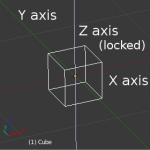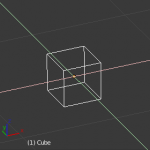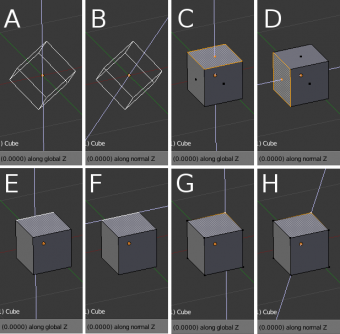Doc:2.6/Manual/3D interaction/Transform Control/Axis Locking
Axis Locking
Description
Transformations (translation/scale/rotation) in Object and Edit mode, as well as extrusion in Edit mode) can be locked to particular axis relative to the current transform orientation. By locking a transformation to a particular axis you are restricting transformations to a single dimension.
Usage
A locked axis will display in a brighter color than an unlocked axis. For example in the image to the right, the Z axis is drawn in light blue as movement is constrained to this axis. This example can be achieved in two ways:
- Press G to enable translation, press Z to constrain movement to the Z-axis.
Axis locking types
Axis locking
Mode: Object and Edit modes (translate, rotate, scale, extrude)
Hotkey: X, Y, Z or MMB ![]() after moving the mouse in the desired direction.
after moving the mouse in the desired direction.
Axis locking limits the transformation to a single axis (or forbids transformations along two axes). An object, face, vertex or other selectable item will only be able to move, scale or rotate in a single dimension.
Plane locking
Mode: Object and Edit modes (translate, scale)
Hotkey: ⇧ ShiftX, ⇧ ShiftY, ⇧ ShiftZ or ⇧ ShiftMMB ![]() after moving the mouse in the desired direction.
after moving the mouse in the desired direction.
Plane locking locks the transformation to two axes (or forbids transformations along one axis), thus creating a plane in which the element can be moved or scaled freely. Plane locking only affects translation and scaling.
Note that for rotation, both axis and plane locking have the same effect because a rotation is always constrained around one axis. Trackball type rotations RR cannot be locked at all.
Axis locking modes
A single key press constrains movement to the corresponding Global axis. A second key press of the same key constrains movement to the current transform orientation selection (except if it is set to Global, in which case the Local orientation is used). Finally, a third key press of the same key removes constraints.
For example, if the current transform orientation is set to Normal, pressing G to start translation, followed by Z will lock translation in the Z direction relative to the Global orientation, pressing Z again will lock translation to the Z axis relative to the Normal orientation. Pressing Z again will remove all constraints. The current mode will be displayed in the left hand side of the 3D window header.
As can be seen in the Axis locking modes image, the direction of the transform also takes into account the selection. Sections A and B show Z axis locking in Global and Normal orientations respectively. C and D show the same situation with face selection, E and F with edge selection and G and H with vertex selection.
Note that using a locked axis does not prevent you from using the keyboard to enter numeric transformation values.


